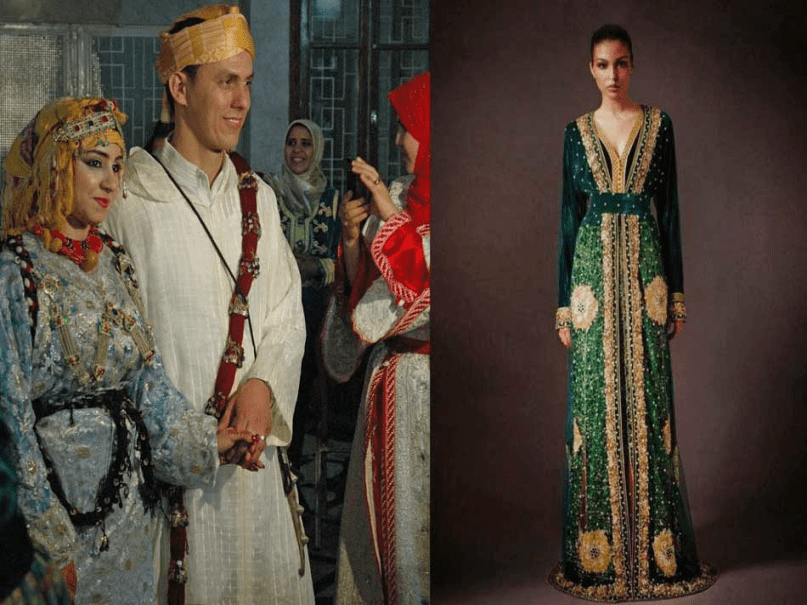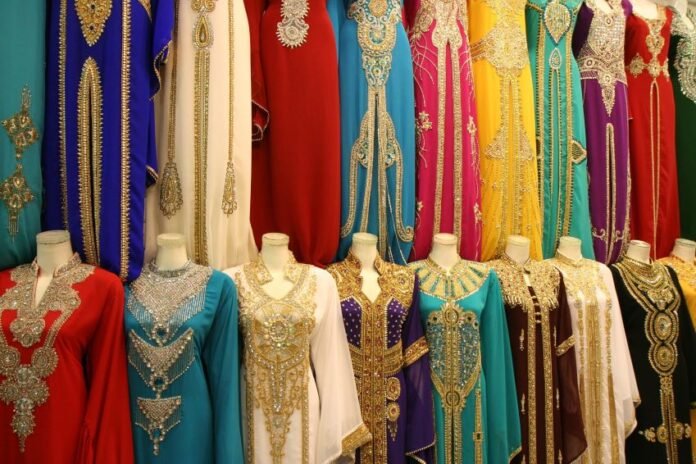Introduction
Morocco is a North African country in the Maghreb region, with a long and rich history spanning over 12,000 years. Morocco’s cultural traditions have been greatly influenced by its diverse ethnic groups and proximity to Europe and the Middle East.
Morocco’s most iconic cultural aspect is its traditional attire, which varies across different regions but retains distinctive elegance, modesty, and heritage elements. In this blog post, I seek to provide an introduction to traditional Moroccan clothing and explore some of its key styles, patterns, fabrics, and meanings within Moroccan society and culture.
While fashion trends today incorporate modern Western influences, traditional Moroccan clothing continues to symbolize notions of national pride, cultural preservation, and religious piety for many Moroccans. The conventional styles also attract interest worldwide for their exquisite craftsmanship and historical significance. I hope this personal exploration of Moroccan cultural dress unveils some of its intricate elegance and deep heritage value for my readers. Let’s begin our journey of discovery!
Traditional Moroccan Women’s Clothing
Among the most visually striking traditional attires for Moroccan women are kaftans, jellabas, and haiks. These flowing silhouettes work well in Morocco’s hot climate while adhering to modesty and propriety in Islamic cultures. Some key women’s styles include:
- Kaftan: An ankle-length kaftan or tunic is perhaps the most formal traditional outfit. Kaftans come in various fabrics like silk and brocade, often featuring elaborate embroidery, contrast stitching, and ornate buttons down the front. Sleeves may be three-quarters or full length.
- Jellaba: Commonly black or dark blue, the jellaba is a loose-fitting robe worn as a coat or dress. Less formal than a kaftan, it still showcases high-quality fabrics and detailing at the cuffs, neck, and hem. Cotton and wool jellabas are ubiquitous.
- Haik: An embroidered or lace headscarf covers the hair and maintains modesty as required in Islam. Finely woven haiks come in cotton, silk, and combinations like silk blended with metallic thread. Haik styles vary across regions.
- Boubou or belliba: Originating from sub-Saharan Africa, the loose-fitting boubou dress has ornately embroidered panels and slits up the sides, usually sleeveless. It adds flair to celebrations in southern Morocco.
- Cherqia: The traditional outfit for rural Moroccan women combines straight pants called seroual with a colorful blouse. Embroidered details distinguish regions like the Rif Mountains.
Traditional fabrics give Moroccan women’s attire an elegant sheen while promoting national craftsmanship. Brocade, silk, cotton, wool, and lace are handwoven or embroidered with stunning precision using gold or silver threads. Distinct regional patterns appear depending on the fabric and garment piece, reflecting cultural diversity across Morocco. Head-to-toe traditional outfits continue uplifting Moroccan artisanship on global platforms today.
Traditional Moroccan Men’s Clothing
Though less ornate than women’s styles, Moroccan men’s traditional attire demonstrates finesse through tailored silhouettes and sophisticated fabrics. Here are some key types:
- Gandora/Jellaba: The classic floor-length pandora coat resembles the women’s jellaba but has no embroidery, featuring a simple tucked collar and cuffs. Solid colors like navy blue are popular.
- Biban: Made of lightweight cotton or linen, the ankle-length Biban tunic has roomier sleeves than a European shirt. Often cream or off-white, it gets paired with trousers for a casual yet polished look.
- Burnous: A hooded wool cloak with ties, the burnous provides Moroccan men warmth and weather protection in colder northern areas. Camel hair burnouses endure harsh desert winds.
- Selham: Working men traditionally wear the selham, a two-piece outfit consisting of plain harem pants tucked into leather boots plus a loose-fitting optional waistcoat/tabard.
- Grand bacha: Formal Moroccan hats come in styles like a classic fez or turban wraps, usually complementing a tailored pandora for dignified mosque or celebration attire.
Quality yet understated fabrics like merino wool, linen, cotton, and camel leather give Moroccan men’s traditional wear functionality alongside elegance. Tailored silhouettes suit Morocco’s climate while retaining a sophisticated appearance prized within its society.

Regional Styles of Traditional Moroccan Clothing
The diversity of Morocco’s regional ethnic groups and varying terrains foster distinctive substyles of traditional dress. Here’s a glimpse into some critical regional clothing variations:
- Rif Mountains – Notable for the cherqia women’s two-piece and belgha wool-weave fabrics, worn in earthy tones. Men sport beluga-knit caps.
- Middle & High Atlas – Colorful striped wool items like the Fouta sash are worn with white cotton djellabas. Silver jewelry complements Berber designs.
- Souss Valley – Elaborate silver filigree on dresses, kaftans, and haiks in the southwestern oasis towns like Taroudant. Rich embroidery graces wedding costumes.
- Sahara Desert – Nomadic Tuareg women are fully covered in indigo robes and veils, adorned by necklaces. Men wear indigo tamaghrait turbans looped elegantly.
- Northern Coastal Cities – Tangier embraces Andalusian influences like scalloped edges, while Fez retains intricate zellige mosaic tile patterns.
- Ouarzazate – Distinctive crimson and navy fabrics reflect this Hollywood filming destination’s wealth and cultural crossroads.
- Marrakech – Iconic medina wares include luxurious silk kaftans, brocade boubous, and gold-threaded haiks in vivid hues.
Each Moroccan region maintains unique traditions, crafting identities through vibrant textiles. Camel leather, Merino wool, and silk portray the land’s diversity beautifully through traditional modes of dress. Cultural preservation remains key as globalization accelerates.
Traditional Moroccan Footwear
No traditional Moroccan outfit would be complete without its classic complementing footwear. Here are some iconic Moroccan shoe styles:
- Babouches: Soft leather slippers worn by men and women, available in varying styles from ornate pointed-toe designs to simple rounded flats.
- Mogassas: Thick-soled Moroccan sandals made from leather or braided palm fibers for summer comfort. Decorative stitching runs up the center.
- Belgha: Sheepskin boots with leather uppers and soles, hand-stitched for warmth in mountainous Rif and Atlas areas and worn by both genders.
- Metatlas: Elongated pointed leather shoes worn by men featuring an upward curving toe, ornamental stitching, and dignified mosque footwear.
- Tan-Tali: Traditional Tuareg ankle boots made of soft camel leather, curled upwards at the toe, adorned simply with stitched designs.
- Derba: Sturdy metal-studded boots ideal for the harsh desert or long Berber treks, with flexible soles enabling agile movement.
Moroccan shoes demonstrate finesse through the selection of materials and construction by skilled artisans in each region. Their designs naturally suit various terrains while staying true to local cultural roots.
Sociocultural Significance of Traditional Moroccan Attire
Morocco’s rich cloth traditions stem from Arab-Islamic, Berber, Sub-Saharan African, and Andalusian Spanish influences. Traditional Moroccan dress reflects the following sociocultural aspects deeply embedded in Moroccan society:
Religious Piety – Modest silhouettes for both genders uphold Islamic values of humility, modesty, and decency. Regional themes reference holy sites.
- Cultural Identity – Distinctive fabrics, patterns, cuts, and accessories enable Moroccans to express ethnic or regional pride through clothes. Berber tribes maintain unique textile crafts.
- Economic Sustainability – Traditional crafts generate income for rural artisans specializing in dying, weaving, embroidery, and more using natural renewable resources.
- Hospitality – Guest-welcoming dress codes incorporate Moroccan grace, sophistication, and abundance through luxurious embellished garments for elite functions.
- Heritage Preservation – Traditions get passed through generations, keeping endangered crafts alive and cultural memory intact against rapid modernity. We are teaching youth these skills.
- Class Distinction – Finer materials like brocade, damask, and gold/silver wire symbolized wealth and status over coarser rural varieties in historic Morocco. Styles differentiated social ranks.
- Environmental Adaptability – Fabrics are suited for hot/cold and dry/humid climates in different areas while being breathable and comfortable for demanding lifestyles there.

